
leather and fur
- The skin or hide taken from an animal, the hair (fur) or feathers
removed, and dressed or tanned for its preservation and use. Prized
for its flexibility and toughness, leather is a material
commonly used in the production of such items as shoes, clothing,
luggage, and saddles.
Fur is leather with a thick coat of hair still attached, much as it was when it was part of a living animal.
Leather,
along with wood and other plant
fibers formed the basis
of much technology in earliest
human history. Early 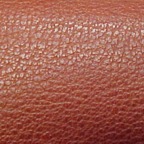 uses included clothing, containers, and tents.
uses included clothing, containers, and tents.
Today, most leather is made from
cow hides.
Lamb and deer
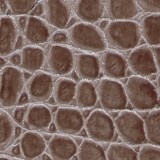 skins
are softer and more expensive. Goatskin leather is known as morocco.
Other skins have been highly prized at various times, and in various
cultures. Among the many exotic
sources of leather have been
skins
are softer and more expensive. Goatskin leather is known as morocco.
Other skins have been highly prized at various times, and in various
cultures. Among the many exotic
sources of leather have been snakes,
crocodiles, sting ray, and ostrich. Each of these leathers is
characterized by its particular texture,
thickness, flexibility,
and durability.
Most leather is prepared by one
of two industrial processes:
it is either tanned (in which the skin or hide is treated with
tannin or tannic acid) or chamoised 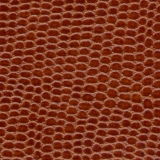 (treated with oils and fats). A skin or
hide that is not prepared in one of these ways either rots or
dries out, becoming hard and inflexibile.
(treated with oils and fats). A skin or
hide that is not prepared in one of these ways either rots or
dries out, becoming hard and inflexibile.
This leather
was prepared from pigskin, which is used in America for footballs,
because pigskin is notably strong, and its texture makes it easy
to grasp.
Once a leather has been tanned, characteristic grains can be brought out by rubbing, or can be imitated by embossing. Finishes include glazing, a high glaze can be produced by rolling with glass cylinders, coloring with stains or dyes, enameling, japanning, or lacquering as for patent leather, and sueding by buffing with abrasive wheels to raise a nap, usually on the flesh side.
Rawhide is similar to parchment and is untanned.
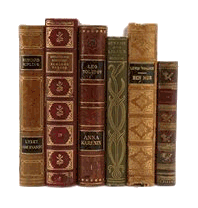 Cordovan, or Spanish, leather, a
soft, colored leather made at Córdoba during the Middle
Ages and often richly modeled
and gilded, is imitated for
wall coverings, panels, and screens.
Cordovan, or Spanish, leather, a
soft, colored leather made at Córdoba during the Middle
Ages and often richly modeled
and gilded, is imitated for
wall coverings, panels, and screens.
Leather
is much used in bookbinding.
Artificial leather, made since the mid-19th century, was originally a strong fabric coated with a rubber composition or with a synthetic substance such as pyroxylin. Since World War II, materials made from vinyl polymers (Naugahyde, Pleather, etc.) have far outstripped the earlier artificial leathers in commercial importance.
Leather is associated by some with sexual fetishism, or with motorcycles, or with some types of music -- heavy metal rock, for instance.
Clay is described as leather-hard when its dryness or moistness makes its flexibility comparable to leather.
(pr. leh'thr)
Examples of works in leather:

Russia, Eastern Altai, Pazyryk Burial Mound
5, Chariot, 5th-4th centuries BCE,
wood, leather, height
300 cm, diameter of wheels
150 cm, Hermitage Museum, St. Petersburg, Russia. See technology.
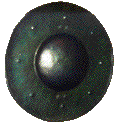
There is a large boss
at the center of this "buckler," a leather shield of
the style used in England in the
13th-15th century. The diameter
of the entire buckler is about 14 inches. Much smaller bosses
encircle the large central one. See arms & armor, English
art, and omphalos.

Japan, Armor
(Yoroi), early 14th century, Late Kamakura
period, lacquered iron and leather, silk, stenciled
leather, copper-gilt,
height 37 1/2 inches (95.3
cm), weight 38 lb. 3 oz.
(17.3 kg), Metropolitan Museum of Art, NY. See arms and armor and Japanese art.

Germany, Tournament Shield (Targe), c. 1450, wood, leather, linen,
gesso, polychromy,
silver, 22
x 16 inches (56 x 40.5 cm), Metropolitan Museum of Art, NY. See
heraldry.
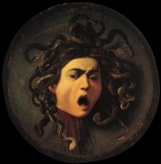
Caravaggio (Italian, 1573-1610), Medusa, oil
on a circular convex
leather shield, diameter
55.5 cm, Uffizi Gallery, Florence. See Baroque, Caravaggisti,
mythology,
and snake.
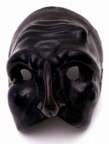
Italian, Mask of Pulcinella, c. 1700, molded leather mask from a Commedia dell'arte theater troupe, The Theatre Museum, London. Pulcinella was traditionally a stupid servant, recognisable from his big beaky nose, hunchback and the wart on his forehead. As the 17th century progressed, the role of Pulcinella became more interesting and more diverse.
 By the time this mask was made, he was not necessarily a servant, but might be a peasant, a dentist, a physician, a painter or a soldier. The mask also changed. Whereas earlier versions had a mustache and beard hiding most of the actor's face, this is a half-mask. Pulcinella was the figure from whom Punch in Punch and Judy puppet shows was derived.
By the time this mask was made, he was not necessarily a servant, but might be a peasant, a dentist, a physician, a painter or a soldier. The mask also changed. Whereas earlier versions had a mustache and beard hiding most of the actor's face, this is a half-mask. Pulcinella was the figure from whom Punch in Punch and Judy puppet shows was derived. Here is a view of the back side of the mask.

Probably Nakota, Yankton Sioux, Northern Plains, Shield, late nineteenth
century, buffalo rawhide, native tanned leather, calico cloth,
hawk feathers, pigment,
diameter 20 1/16 inches
(51.0 cm), Cincinnati Art Museum, OH. See American
Indian art.
![]()
A'ani/Nakoda (Gros Ventre/Assiniboine; Montana,
Fort Belknap Indian Reservation), Pair of moccasins, c. 1880-1910, animal
hide, beads, 4 1/8 x 4 7/16 x 11 7/8 inches (each), Minneapolis
Institute of Arts. See American
Indian art.

Nigeria, Lower Cross River, Ejagham peoples,
Headdress, 19th-20th century, wood,
leather, metal, bone,
fiber, paint, height
10 31/32 inches (27.8 cm), Metropolitan Museum of Art, NY. See
African art
and mask.

Democratic Republic of the Congo, Songye
peoples, Power Figure, 19th-20th century, wood, copper,
brass, iron, fiber,
snakeskin, leather, fur,
feathers, earth, resin,
height 39 inches (99.1 cm),
Metropolitan Museum of Art, NY. See African art.
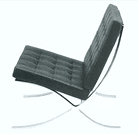
Ludwig Mies van der Rohe (German-American,
1886-1969), designer, Barcelona Chair, 1929, chrome-plated steel and black leather. See Bauhaus, design, and furniture.

Marcel Breuer (German, 1902-1981), Wassily
Chair, 1925, chrome-plated steel and black leather and furniture.

Joseph Beuys (German, 1921-1986), Infiltration homogen für Konzertflügel
(Homogeneous Infiltration for Piano), 1966, piano covered
with felt and leather,
100 x 152 x 240 cm, Georges Pompidou Center, Paris. See Fluxus.
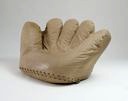
Paolo Lomazzi, Donato D'Urbino and Jonathan De Pas, manufactured by Poltronova, Italy, Joe Sofa, 1968, polyurethane foam and leather, 33 1/2 x 65 1/4 x 41 3/4 inches (85.1 x 165.7 x 106 cm), Museum of Modern Art, NY. See furniture.

Joseph Beuys, Die Haut (The Skin), 1984, felt
and leather, 100 x 152 x 240 cm, Georges Pompidou Center, Paris.

Wayne Eagleboy (American, Onandaga, contemporary), We the People, 1971, acrylic paint and barbed wire on buffalo hide, Art Wagon Gallery. Contemporary Native American Wayne Eagleboy's version of the US flag is framed with fur, and bears portraits of two Indian men behind a screen of barbed wire.

Robert Brunner, Daniel De Luliis, Jonathan
Ive, Jay Meschter, for Apple Computer, Inc., 20th Anniversary Macintosh, 1997, limited edition, injected
molded ABS plastic, die-cast
zinc, leather, silicon,
rubber, fabric, 17 1/4 x 16 1/2 x 13 inches (43.8 x 41.9 x 33.0
cm), San Francisco Museum of Modern Art. See design.

Jose Antonio Rios (Peruvian, contemporary) and his family, "Colonial Garlands" Jewelry Box, 2003, tooled leather on plywood, velour lining, height 3.0 inches, diameter 6.3 inches, weight 0.4 lbs. A member of the Rios Family has tooled the leather with hammer and chisel, replicating foliate patterns of vines and garlands, reminiscent of Peru's colonial epoch. Jose Antonio Rios said, "For us, embossing leather is a family tradition. My father inherited it from his father, and handed it down to us." Also see vessel.
Also see applied arts, art conservation, basketry, fetish, ink, Kolinsky, paper, stump or stomp, and surface.
https://inform.quest/_art